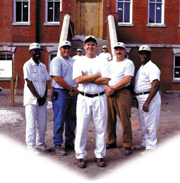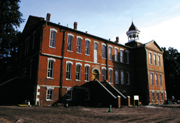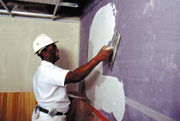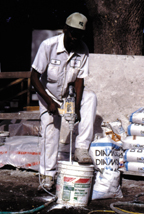

"It's an old building and the county wanted to restore it to its original look," says William T. Swafford, vice president and chief estimator, Baylor Plastering & Drywall Inc., of Holly Hill, Fla. "We had to determine which plaster application would be the most appropriate."

High-profile work
"The value of this project was not in the dollar amount, but in the high-profile nature of the work," says Swafford. "Many firms don't like these kinds of jobs. There are liability and warranty issues in regards to the performance of the new work over the existing surface, so that many companies veer away from doing this kind of thing."Since Baylor had to overcome those concerns, this meant using plasterers with finely honed skills.
"We needed true craftsmen who know old-time plasters and textures--real pros who can hand-mix material, do patches and build up thickness," says Gary Dillman, CEO, Baylor Plastering.
Baylor Plastering & Drywall, formerly the Henry Baylor Plastering Co., has a long and distinguished plastering heritage that traces back to 1949. As such, the company has many long-time plasterers on its payroll who were a perfect match for the courthouse project. According to Dillman, the individuals assigned to the job each had more than 25 years of experience.

Can't crack, won't crack
With the people in place, the challenge became finding economical applications using the right materials."We were concerned about going over existing substrates. We thought there would be a great danger of new material cracking," says Swafford.
Since the county wanted to bring back the look of the original plaster walls, Baylor Plastering officials felt they needed to keep as much of the original material in place as they could. The company trialed a variety of plasters and veneer plaster systems, but finding workable solutions didn't come easily. In fact, the company initially completed a one-room mockup using a particular plaster system that Dillman says involved gauging plaster, but the time and expense involved didn't permit its use.
"Besides, we wanted to obtain an old-time plaster look through the use of modern products," says Dillman.
The renovation involved a combination of patchwork repairs and complete wall overhauls right down to the original wood studs and wood lath--removing old plaster with horsehair.
In these areas, the plasterers furred out with metal lath and applied scratch and brown coats of sanded Structo-Base Gypsum Plaster, manufactured by United States Gypsum Co. The product enabled mechanics to provide substrate strength and rigidity (it provides 2,800 psi when tested in accordance with ASTM C742) and helped meet the design demands of creating true straight planes.
After allowing the scratch and brown basecoats to set and cure, they applied a bonding agent to enhance and fortify the adhesion of the topcoat. For this project, USG's Diamond Brand Interior Finish Plaster (both Regular and Sanded Finish) was used.
Of course, not every wall in the building had to be torn out and redone. Many were in good shape and just needed new patchwork that blended with the original plaster.
Most of the walls in the hallways, for example, had only small check-crack areas. Here, Baylor Plastering plasterers created an old-time, "rippled" texture effect. Around the perimeters of these patch areas, crews applied mesh tape, plaster bonder and a coat of Diamond plaster.
"The architect loved it," says Dillman. "It was exactly the look that she wanted."
Baylor Plastering's work at the historic Osceola County Courthouse was a success on the exterior as well.
Outside, crews upgraded much of the exterior architectural detailing, including column capitals, cornices and moldings. Dillman says it would have been easier to use foam forms and some concrete, but county officials insisted that the repairs be as true to the original materials as possible.
In fact, the county requested that Baylor Plastering use old-time gauging plaster-lime, sand and Portland cement--so that, says Dillman, "if somebody tore it off you wouldn't be able to tell it had been remodeled."
The combination of the right materials, an experienced crew and good project coordination made the project successful. Dillman says the general contractor, Centex Rooney/Gray Construction, really came through.
"The pre-construction and weekly project meetings they orchestrated were very productive," he says. "I'd say the general contractor and the group of subs that worked on this project were the cream of the crop--and that's why it all came together so smoothly."

Report Abusive Comment